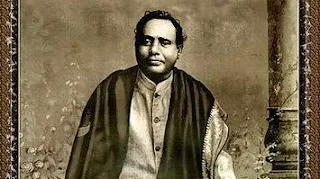Kumaranasan is a poet who left a unique mark on the path of renaissance in the history of Malayalam poetry and literature after Thunchat Ezhutchan. Aasan, the master of modern poetry, left us in 1924. Aasan managed to sow the seeds of transformation in poetry during his short life. Malayalees called Aasan as love singer and magnificent idea. Aasan, who was closely associated with Sree Narayana Guru, also served as the General Secretary of the SNDP Yog for a long time. Aasan was equally concerned with social revival and revitalization of Malayalam poetry.
Karuna is 100 years old:
On this occasion of the 150th birth centenary of Mahakavi Kumaranasan, Karuna, his most famous work, deserves a special mention. Karuna is the last poem written by Kumaranasan before he died in a boat accident at Pallanayat in 1924. Karuna is a poetic version of the story that took place in the days when Buddhism was strongly shining in Uttara Mathura. Aasan was a poet who traveled all over India and gained deep life experiences. Hence, North India is the setting for many of Aasan's poems. Karuna is also a poem born in the same context. The poem is organized in two parts. This poem was composed in 1923.
How about Karuna story:
The poem depicts the life of Vasavadatta, a courtesan who lived in Uttara Mathura. Vasavadatta, a countess, will earn a lot of money. Vasavadatta was approached by many high-ranking people. Despite being a prostitute, Vasavadatta falls in love with a Buddhist preceptor named Upagupta. Vasavadatta sent Toshi several times with the message that he was interested in meeting Upagupta. Upagupta says that it is not time, it is not time. This has a great impact on the habitat. He is a sex worker. Vasavadatta also doubts that Upagupta misunderstood that he was saying that he wanted to see him as part of his profession. He did not come because he had no money to give.
In this way every thought about Upagupta is stuck inside and Vasavadatta's patience is eroding. Later, an argument over Ganika Vritti results in murder. Vasavadatta is convicted of murder. Upagupta arrives to see Vasavadatta lying in the forest after cutting his hand. This occasion is the climax of the poem. They are understanding the meaning of Upagupta's saying that it is not time, it is not time. The great message of life is mercy and kindness. The poet expresses the depth of compassion as the tears of Buddha Bhikkhu fall on the body of Vasavadatta who is lying in a plight. And the eternal truth of Nirvana.
Buddhist influence:
Karuna and Chandala Bhikshuki are two works where Buddhist influence can be clearly found in Aasan poetry. Buddhist principles are one of the main features of Aasan poems.
Popular poetry:
It can be said with certainty that Karuna, which is celebrating its hundred years, is a collection of poetry that has been cherished by the hearts of the people. Later the work Ramanan also received popular support. These works penetrated deeper into people's hearts through different narrative fields such as drama, storytelling and cinema.
Karuna – Drama, Storytelling, Cinema:
When a work gets stuck in people's mind, that work shows different narrative possibilities. Ketamangalam Sadanandan, a famous poet, told the story of Karuna on several platforms. In 1966, playwright Vaikam Chandrasekaran Nair directed the play Karuna. Later K.Thankappan directed and produced Karuna on the silver screen. The actors were Thikurishsi, Ummer, Madhu and Adoor Bhasi, the favorite actors of the Malayalees. Through these art forms, the idea of the poem of mercy could be reached to different people.
Color is important:
Colour is the main feature of Aasan's poems. This kind of embellishment increases the beauty of the poem tenfold. The poem begins by describing the Buddha and the Sun. Then the beauty and glory of Vasavadatta is described. In one word it is a visual feast of lyrics. World philosophy is also the main feature of Aasan poems.
The lyrics in Karuna are world philosophy. It is human nature for a person who has had a full stomach to want to eat something special. Vasavadatta is visited by rich and famous people which pleases the courtesan Vasavadatta. But Kumaranasan makes it clear through ornamental use that it is a worldly/human instinct to feel desire when one sees the distinguished spirit of Upagupta.
Elsewhere:
The thought of Vasavadatta Upagupta, a sex worker/ courtesan, makes the mind sad. She is longing to see Upagupta. Love is a feeling that originates from the mind. She has no thought of the body at this moment. But later, when clients approached her, Aasan narrates that she went back to sex work just like a flamingo that has come out of the pond and goes back to the pond. Many such decorative uses strengthen the depth and inner strength of the poem.
The beat of Vanchipaat:
Karuna is composed in nathonnatha vrutta in the rhythm of Vanchipat, but many poetry lovers leave the rhythm of Vanchipat and recite it in other rhythms. Karuna is a work that needs to be re-read after reaching one hundred years. A number of research papers have come out pre-dating Kumaranasan's work, and as time goes on, its core is growing. Let us hope that the time to come will also embody the eternal truth of Karuna/Nirvana.

